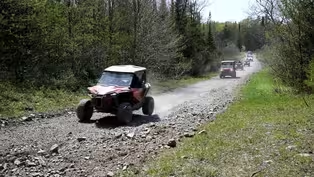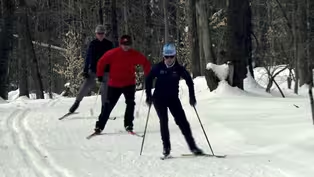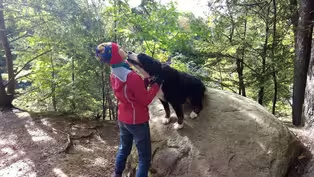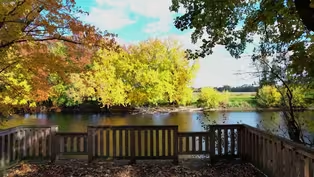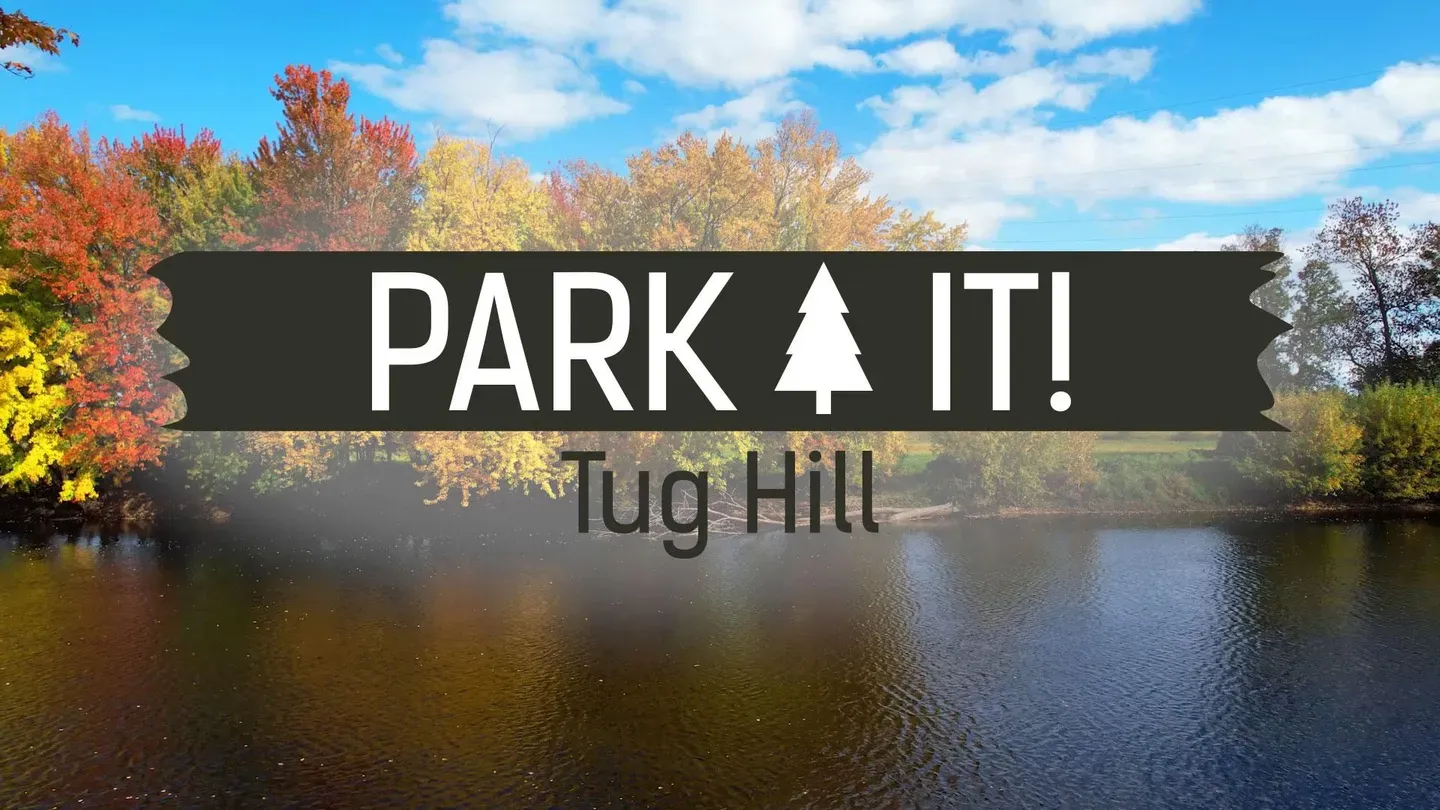
Park It!
Park It! Tug Hill
10/26/2023 | 28m 38sVideo has Closed Captions
Uncover what Tug Hill is all about in the latest documentary in WPBS’s “Park It!” series.
Take a four-season look at the snowiest region in America east of the Mississippi. Adventures include hiking, leaf peeping and fishing in the Autumn, to snowmobiling and snowshoeing in Winter, spring birding and ATV-ing, and summertime camping, swimming, and boating – while also visiting some of the area’s historical attractions and businesses.
Problems playing video? | Closed Captioning Feedback
Problems playing video? | Closed Captioning Feedback
Park It! is a local public television program presented by WPBS
Park It!
Park It! Tug Hill
10/26/2023 | 28m 38sVideo has Closed Captions
Take a four-season look at the snowiest region in America east of the Mississippi. Adventures include hiking, leaf peeping and fishing in the Autumn, to snowmobiling and snowshoeing in Winter, spring birding and ATV-ing, and summertime camping, swimming, and boating – while also visiting some of the area’s historical attractions and businesses.
Problems playing video? | Closed Captioning Feedback
How to Watch Park It!
Park It! is available to stream on pbs.org and the free PBS App, available on iPhone, Apple TV, Android TV, Android smartphones, Amazon Fire TV, Amazon Fire Tablet, Roku, Samsung Smart TV, and Vizio.
Providing Support for PBS.org
Learn Moreabout PBS online sponsorship(gentle music) - [Announcer] Park It: Tug Hill is sponsored in part by: The Tug Hill Commission.
- [Spokesperson] Brookfield Renewable, a leader of renewable power, is a proud partner of WPBS-TV.
Make safety a priority.
Know the risks.
Use caution in and around water.
Information available at safewaters.com.
- [Announcer] Closed captioning provided by: The Pratt Northam Foundation.
- [Narrator] The Tug Hill region covers 2,100 square miles of land in upstate New York.
This vast tract of land is twice as large as the Catskills.
The entire state of Delaware could fit inside the region.
Tug Hill encompasses land in four counties: Jefferson, Lewis, Oswego, and Oneida.
Small villages and towns populate the region, with roughly 100,000 residents.
But the core of Tug Hill is approximately 275 square miles of wild forest, considered one of the most remote areas in New York State.
Tug Hill has a rich history and culture, from pre-settlement days through land purchases and waves of immigrants coming to Tug Hill to work toward a better life than what they had in their home countries.
Places like the Black River Canal Museum, Constable Hall, and other historical museums and societies across the hill can be explored for research.
Local culture and regional musical tradition can also be found in The North American Fiddlers Hall of Fame and Museum, which showcases musicians every Sunday afternoon in the summer.
Tug Hill's culture continues to be influenced by the resources that gave rise to its patterns of settlement: Farming, logging, fishing, and hunting.
And the Tug Hill is known for its abundance of natural resources: Sparkling lakes, streams, and ponds, ample forests, fields for farming, a variety of wildlife and wild game, plentiful sunny days and wind for renewable energy sources, a jaw-dropping amount of snowfall, and more.
It's these natural resources that make the area not only a favorite place to live or visit, but a four-season economic powerhouse.
Fall through summer, the Tug Hill never rests, with activities, adventures, and opportunities all year-round.
(light music) Nothing says fall like apples, pumpkins and apple cider.
Roadside stands and farmers markets throughout Tug Hill are plentiful with the fruits of the fall harvest.
The Burrville Cider Mill was built in 1801 and operated as a sawmill.
The Mill is located at the headwaters of the North Branch of the Sandy Creek in Burrville, on a 30-foot waterfall that was used to turn a turbine that powered the Mill equipment.
- Cider is just the squeezing of an apple, but a lot of people wonder what the difference is.
Apple juice is more filtered.
It has sugar added.
It might have water added to it.
Cider, we just squeeze an apple and you got cider.
We also make our donuts with our cider.
We make fudge here.
A lot of baked products we make here too.
The waterfall, this is what ran the cider mill when it was a sawmill.
It was powered by the waterfall.
Over the years, that changed.
The old press, when we bought the building, that old press was a hydraulic press.
Right now we have an electric press, but the waterfall didn't have a name before.
It was on the maps, but it never had an official name.
It is now called the Burrville Cider Mill Falls.
(light music) - [Narrator] Another popular fall activity, actually popular year-round, is hiking.
Tug Hill offers many hiking trails for people of all ages and abilities.
Local parks, state forests, and state parks offer miles of trails with a variety of scenic opportunities, including waterfalls, gulfs, and viewing the fall foliage, or leaf peeping.
A favorite place to hike year-round is Whetstone Gulf State Park.
Over five miles of trails wander along a three-mile gulf that has been called one of the most spectacular scenic vistas east of the Rocky Mountains.
- Well, Whetstone Golf has beautiful views at different spots along the way.
You can catch nice waterfalls at the upper end and it has a nice view overlook platform that you can look out over the valley of Black River.
And so it's really nice views along the way.
It's a nice little hike.
It's not too difficult to get around with kids and the family, and so that's what we enjoy the most about it.
- There's this term called forest bathing that people have kind of caught onto, and it's basically just being out in nature, being out in the trees, pine trees, just the smell is actually very comforting to some people.
- Listening to the sounds, taking in the scenery.
It's a way to kind of reset yourself and just to kind of relax and not think about your worries that are going on in your life.
So it's a good way just to kind of bring yourself back center and center yourself, basically.
- Whetstone is neat, because you can hike from the entrance straight out along the creek and then keep following up, and the sides of the gorge get taller and taller.
And it's also great for cross-country skiing.
And we can take the dogs, and our kids, and picnic.
So you can go any season.
And then, if you're really ambitious, you take the upper trail that's like three miles long, the north loop around, and you can see a falls and come back to this lookout.
- [Narrator] Fishing is another year-round popular activity.
The watersheds of the Black River, Salmon River, Mohawk River, Oneida Lake, and the Sandy Creeks provide pristine water for nearly 4,000 miles of streams and four reservoirs, and nearly 117,000 acres of wetlands.
In the Fall, visitors and residents alike fish waterways such as the Salmon River for salmon.
Wintertime is the time to catch steelhead trout.
In the spring and summer, bass, pike, walleye, and trout are plentiful.
- I started fishing here 30 years ago.
I love the area, love the river, love the people.
The fishing here is something that is addicting, which is why I've been coming for so long.
And as you look around here, you'll see a lot of the people that I see every year.
Year after year after year they come to the same spot from all over the country just to catch these fish.
- So we're out here at the beautiful Tug Hill Plateau fishing the Salmon River Reservoir in Redfield.
We're out here catching a couple small mouth bass today, but there are multitude of other species that you can catch.
There's perch, trout, salmon, crappie, multitude of things that you can come out here at all seasons.
You can fish spring through winter.
It's beautiful all year long.
- Fishing for these fish takes several different types of tackle.
You can use, as I have here, a spinning rod and reel.
I have a nine-foot rod with a spinning reel.
I also use a fly rod and you'll see many people here using fly rods as well.
- There's lots of access points around the lake for either shoreline fishing, or if you'd like to put your boat in there's also those access areas.
There's also some stream fishing on the north branch of the Salmon River, if you would like to get into that, on the Mohawk and the Deer Rivers, and also on the Sandy and Fish Creek.
- The biggest salmon I've ever caught was 39 pounds.
I caught it right here, many years ago, and it was a thrill of a lifetime.
- [Narrator] Nature provides many fish naturally to the Tug Hill region, but some organizations like to help keep fishing plentiful.
Every year in early May, the Redfield Fish and Game Club stocks local waterways with brook trout, rainbow trout, and brown trout.
- Brook trout go in the north branch of Salmon River and brown trout and rainbow go in the east branch of Salmon River.
New York State's fish biologists do a survey every 10 years to determine how many fish to stock and where to stock the species.
- [Narrator] The Salmon River Fish Hatchery also supplies fish to more than 100 local public waterways.
The Fish Hatchery, located in Altmar, New York, stocks approximately 3.5 million trout and salmon.
All this leads to one undeniable fact: Fishing is plentiful on Tug Hill.
Fishing tournaments abound, and one special one is the Kids Fishing Derby, hosted by the Redfield Fish and Game Club.
Participants can be up to 15 years old, and no experience is necessary.
- This event is great for first time fishers because it gives the kids an opportunity to learn how to do basic fishing skills.
- I enjoy fishing because it's a great way to get outdoors and just have some fun.
- I like to fish because I get to spend time with family.
- I caught some brooky trout and a really big bullhead.
- [Tracey] It's just nice to see the excitement on their face when they catch a fish.
- [Narrator] Come winter, the landscape changes dramatically.
Leaves are long gone from the trees, and the land prepares for the hardy winter ahead.
A phenomenon called Lake effect snow occurs when cold air passes over warmer water.
The vast expanse of nearby Lake Ontario supplies that warmer water in abundance.
It's not unusual for areas of the Tug Hill region to experience over 25 feet of snow in a single winter.
Record-breaking snowfalls of over 40 feet in a single season have occurred.
With so much snow, enthusiastic residents and visitors alike are drawn to the region for winter activities such as snowshoeing, snowmobiling, cross-country skiing, and more.
- I mean, cross-country skiing, I've been doing it for over 40 years myself.
It's a lifelong sport.
We have many trails on the Tug Hill plateau and around this area.
We have higher end trails that are a little bit more difficult.
We have a good assortment of medium to easy to less challenging trails.
So we can accommodate all types of skiers from beginners to more expert skiers.
We have quite a few people that come from out of the area to ski here.
So there's lots of different things that make it enjoyable to come out and cross-country ski.
- The fresh air, the snow.
It's just a wonderful sport to keep you in shape.
Socialization, you meet wonderful people and I love to be out in the wintertime.
- It gets me outside, but also it's a great exercise.
It's low impact.
I couldn't jog anymore, so took up the cross-country skiing and I feel better when I get off the skis than when I got on.
- What brings me to Tug Hill region is the amount of snow that we have in this region.
Natural snow, it could be absolutely no snow in Syracuse and you drive within an hour and two or three feet of snow.
So that's why we come up here to ski.
- [Narrator] Opened in 1945, Snow Ridge Ski Resort in Turin, New York takes advantage of the region's massive snowfall, an average of around 200 to 250 inches per year, to offer downhill skiing, snowboarding, and tubing.
- So, we say that Snow Ridge has a big mountain feel for a little mountain, meaning that we have the glades and the powder, things that you can find at bigger mountains, but we offer it right here.
So we're really unique for that.
We're also really family oriented, so we offer things for the little kids that are learning how to ski, adults that are learning how to ski, great progressive terrain.
It's just such a unique hill.
We have everything that a family could want, no matter your ability.
You can go to any big mountain and you could pay for that experience, and it's going to be awesome and you know what you're going to expect, but there's something so special about still coming to these small family owned resorts and there's just not many of us left.
You're supporting a family.
So, it's really unique that we are still standing strong and the energy that you have here is just so different than a big mountain.
The community that we have here is really special.
- [Narrator] Snowshoeing has been a mode of local transportation on Tug Hill for a very long time.
Early indigenous populations such as the Onondaga and Oneida nations were likely the first to use snowshoes to navigate Tug Hill's harsh winter terrain.
Snowshoes allow the wearer to walk on top of the snow, without sinking in to the knees or hips.
Tug Hill offers many trails favorable to snowshoeing.
- Oh, my favorite places to snowshoe?
The first one is here.
We're at the Joseph A. Blake Wildlife Sanctuary in Rutland, and this is the flagship property for Tug Hill Tomorrow Land Trust.
We have a developed set of trails that we hike on, and snowshoe and ski on in the wintertime.
I love coming out here.
It's 140 acre property, there's lots of places to explore, and lots of wildlife to see and observe.
Gosh, there's all sorts of places to go on Tug Hill, and they're all contained in a recreation guide that's out there.
The Tug Hill Recreation Guide is free.
There are over 25 sites in that recreation guide, I believe, where people can go and do all sorts of recreational activities, including snowshoeing.
- [Narrator] Tug Hill is known for some of the best snowmobiling in the Northeast.
Its approximately 500 miles of groomed trails are part of New York State's over 10,000-mile trail system.
- The Tug Hill region, I like the Tug Hill region best, I guess is, one, it's friendly and receptive everywhere you go.
The trail system itself, based on all the stops along the way, you never feel like you're too far out of touch.
Even though you're out in the wilderness, you're not.
There's always safety and a place to stop and get warm or something to eat, always within every 15, 20 miles.
I've ridden in a lot of spots around the country, Canada, and it can get a little worrisome sometimes when you're out 70, 80 miles from safety.
And there's always a friendly face when you walk in any of the venues around here.
- Tug Hill region is absolutely awesome for snowmobiling.
There's lots of snow.
Once it gets snowing up here, sometimes it snows almost every day, so it stays white and pretty and it's just beautiful.
- [Narrator] You do not have to own a snowmobile to enjoy the sport.
Various snowmobile shops in the Tug Hill Region rent sleds as well as the clothing and gear to go with it.
- [Kim] It's just getting outdoors, get away from the electronics, the TVs, the computers, tablets, and stuff like that, and just spend some good quality family time with each other.
- [Narrator] While trails are free with no permit required, snowmobilers must be registered with New York State and are encouraged to join one of the local snowmobile clubs.
Clubs help keep trails groomed and often have special agreements with local landowners for private trails.
- We usually go out at night when the conditions are right and basically take bumpy trails and make them flat.
For Turin Ridge Riders, we do around 40 miles of trails.
Where we stop, another club picks up.
We groom pretty much every day when there's snow and the traffic's busy.
- [Narrator] And one last tip for those interested in trying the sport.
- New snowmobilers in the area, make sure you get a map.
Trails are typically marked very well, but a map is helpful so you can look at where you're going.
Take your time, don't drive super-fast.
Get used to your machine and enjoy the ride.
(snowmobile engine roaring) - I mean, there's many different activities.
The snowmobiling, the Cross-country skiing, the snowshoeing that make life just fun and enjoyable.
People meet other people from other areas, become friends, ski together.
It's just nice to see people with smiles on their faces and try and enjoy the wintertime.
- [Narrator] The fun doesn't stop once the snow melts.
Come spring, the ATVs and other off-road vehicles come out!
Hundreds of trails and seasonal roads offer a terrain for all levels.
Trail permits are required to ride in some places.
- The trails in the Tughill region kind of fall into different categories.
Some of them are real rural and so you're going to be going through mud holes.
A lot of them are nothing but blacktop roads.
And then you've got, of course some that are dirt roads and so on.
So you have all sorts of variety as you're out there riding.
We're going out today, and ride the trails around up through.
And then we stop somewhere to eat and some of the times we take our lunches with us and eat on the trail and sometimes we take prepared food and stop at a campground and eat.
What I love about ATVing in the Tughill region, there's a lot of trails up here that are open so you can ride in a lot of places.
I say it gets us outdoors and it's something that my wife and I can do together and instead of having to stay home and wash dishes (laughs).
- [Narrator] With the spring thaw, comes a local culinary favorite, maple syrup!
New York State is home to the largest number of tappable maple trees in the United States.
The origins of maple syrup date back hundreds of years to indigenous populations, who were making maple syrup long before the Europeans arrived in North America.
The sap from native maple trees starts running as the days get warmer, while the nights stay cool.
A common sight in March is tree tapping, the gathering the sap and boiling it in a sugar shack to make what locals refer to as liquid gold; maple syrup.
It takes on average, 40 gallons of sap to make one gallon of maple syrup.
- We tap about 12,000 trees and that's where we get our product from.
Our process for making maple syrup starts in the woods with the trees.
When the temperature starts to do a freeze-thaw cycle is when we start to get sap from the trees.
The sap is essentially 98% water when we take it from the trees.
And then we run it through a reverse osmosis system where we remove most of the water first.
And then we boil off the rest of the water on the evaporator to a certain temperature to make maple syrup.
We are all on tubing with a vacuum.
So we have a series of tubes connecting each trees that goes to one main collection tank versus the traditional way where they would hang a bucket on each tree and gather each tree.
Our sap is all coming to one main point where we get the sap from.
The best trees for producing maple sap are hard maples.
And the older, the better it seems.
The sugar content tends to be a little better in older trees.
- Products we make at Snyder's Sugar Shack, we do a little bit of everything.
Mustard, barbecue sauce, hot sauce, garlic rub, infused syrups, coffee infused vanilla bean, cinnamon flavored syrup.
- [Narrator] Visitors can see for themselves how maple syrup is made, and sample some of the products at area sugar shacks, during Maple Weekend in March.
Another way to learn about maple syrup production, its history, and its importance to the local economy is to visit the International Maple Museum Center in Croghan, New York.
- There's the history from maple producers of how they did it from horses, drawn carriages, from now we use tractors, we even put snow sleds on and try to get to the trees when you've got four to five feet of snow.
Tug Hill region is known for snow load.
So, can you imagine how it was for those past people trying to get to Sugar House?
That's where they were stuck, and that's where they made maple syrup.
There is a small evaporator room downstairs, so you can actually see how an evaporator is set up.
There's tubing and spiles and buckets and artifacts that you never heard of and that you can see and walk around and view in the museum.
- [Narrator] Agriculture is a large part of the economy of New York state, and Tug Hill in particular.
The popularity of local food and beverage products and specialty personal-care items has inspired some farmers to grow unique and different crops.
Hopenhagen Farms in Copenhagen, New York, specializes in the growing of both hops and lavender.
- We started to grow lavender because, we actually didn't start with lavender, we started with hops.
So after I started growing the hops, and it's like I've read different things and they said that lavender goes well with hops.
And so I did some research.
We visited lavender farms.
I did a lot.
I did an online course on lavender and found a greenhouse in Pennsylvania that said that they had lavender hardy enough to grow in our zone four.
And so that's how we started.
We got some plants and we planted them that first year in 2016 and we've just grown from there up to nine species that are viable in our zone four here in Copenhagen.
There are many ways that you can use lavender in products.
You have what's called culinary lavender, which is edible lavender.
You can use it for baking, seeping for tea.
And also you can use lavender in other things such as making soap.
Lavender is one of the most popular herbs to use because it's so diverse with all the different things that you can use it for.
- [Narrator] Each year, Hopenhagen Farms celebrates the lavender, and the summer, with a Lavender Festival, featuring vendors, lavender foods and beverages, and music.
The discovery that grapes can survive a harsh winter climate like that on Tug Hill has led to a strong local winery and distillery industry.
The Tug Hill Estate Winery was established in 2007 with over 15 acres of cold-hardy hybrid grapes, blueberries and raspberries.
Today, the winery produces over 15 different varieties of wine.
In 2018, the winery launched Tug Hill Spirits, offering regionally-inspired brandy, vodka, and rum.
- It's a great place to have a business.
It's a great place to run a business.
The people are great.
There are a lot of outside people for outdoors adventure during the summer, and snowmobile and outdoor ventures during the winter, as well.
So, we have a different demographic of customers all year round.
We really enjoy that and we really appreciate that.
- [Narrator] Not all harvesting on Tug Hill includes soil or the growing of crops.
Windfarms harvest the wind to create sustainable, renewable energy.
In fact, four separate windfarms call Tug Hill home.
The Maple Ridge Wind Farm is the largest wind farm in New York State.
It's 195 wind turbines can produce a maximum of 321 megawatts of electricity.
Nearby, The Number Three Wind Farm's 27 turbines create 104 megawatts of electricity, enough to power 30,000 households.
- We build windmills on Tug Hill because that's where there's really strong wind resource.
So actually, you don't see the wind farms on the western edge of Tug Hill so much.
They're all right contiguous to one another on the eastern edge because the wind comes off Lake Ontario, blows up and over Tug Hill and it's on the down slope that the wind accelerates the most and the strongest winds are.
Wind farms contribute a number of different revenue sources to the local economy.
There's payments in lieu of taxes and there's a lot of local purchasing, and there's local employment both for the construction phase in addition to the operation staff that operate the project on a permanent basis.
- [Narrator] Once spring arrives on Tug Hill, long dormant trees and flowers begin to bud, and the local wildlife welcomes the return of warmer weather.
One popular pastime on the Hill is birding.
Tug Hill offers a variety of habitats and many different species of birds.
- You can find different species of birds at different times of day.
Of course, owls, whip-poor-wills, those kinds of birds like to be out at night.
Most of our owls you'll find in wooded areas and on the edges of woods and fields at nighttime, and then there are other birds that like to be out in the day, songbirds in particular.
Birds that kind of forage for insects and things in fields, you can find them almost any time of day hopping around in grassy areas, mowed areas.
In the evening too, the birds will be more active then as well, so you'll hear more song birds and evening birds.
- [Narrator] One local hotel created another way to celebrate the local wildlife.
Every year, the World Famous Osceola Hotel, in Osceola, New York, hosts their Annual Turtle Races.
In 2023, the race marked its 50th anniversary.
They don't move very fast, usually, but the excitement is contagious and everyone roots for their favorite turtle.
The event includes vendors, food, and activities for kids.
Indeed, wildlife, and the natural beauty of the Tug Hill region attracts visitors from across the country.
Many appreciate the opportunity to get outdoors and experience what the region's landscape has to offer, including camping, swimming, and boating.
State parks and private campgrounds offer a variety of experiences, from very rustic to full amenities.
- Whitaker Park is owned by the town of Martinsburg.
Camping is no reservations.
You can come, it's first come, first serve.
We have two bathhouses with hot showers.
We have playground for the kids, ball field, basketball court.
We have two pavilions, one that can hold about 180 people.
We have fresh water here for camper fill up.
We have all the amenities for camping.
No hookups, we're actually a dry campground.
Waterfalls is a real big attraction.
We get people from all over the state, out of state because it's part of the New York State Water Trail system.
- [Narrator] Many folks don't realize it, but the Tug Hill region encompasses the entirety of Oneida Lake, just north of Syracuse.
Oneida Lake is the largest lake entirely within New York State.
It is over 20 miles long and five miles wide, with an average depth of 22 feet.
There, boaters in pontoons, cruisers, fishing boats, jetskis, and non-motorized watercraft can all be found enjoying the splendor of the lake.
Onshore, places like Sylvan Beach are popular with sun-worshippers and beach-goers alike.
And that's what Tug Hill is all about.
The beauty and exquisiteness of nature, the opportunity to experience the land first-hand, the natural resources that provide economic and recreational benefits, cultural heritage and historic sites, and just plain fun.
The beautiful scenery of waterways, waterfalls, local parks, state forests, and wilderness areas provide the perfect backdrop for a relaxing day away from the everyday grind.
So go ahead, explore the outdoors.
We'll see you on Tug Hill!
- [Announcer] Park It: Tug Hill is sponsored in part by: The Tug Hill Commission.
- [Spokesperson] Brookfield Renewable, a leader of renewable power, is a proud partner of WPBS-TV.
Make safety a priority.
Know the risks.
Use caution in and around water.
Information available at safewaters.com.
(light music)
Clip: 10/26/2023 | 1m 27s | Cross Country Skiing in the Tug Hill region. (1m 27s)
Providing Support for PBS.org
Learn Moreabout PBS online sponsorshipSupport for PBS provided by:
Park It! is a local public television program presented by WPBS
